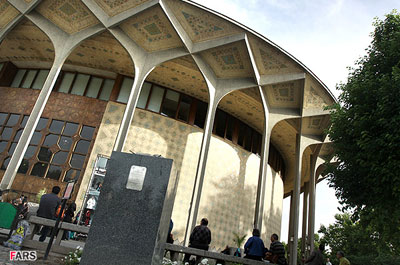 Iran Focus: Tehran, May 19 – Art works and monuments paying tribute to prominent Iranian figures have “mysteriously” disappeared from Tehran parks and public squares as officials proceed with plans to dedicate green space to memorials of the 1980-88 Iran-Iraq war.
Iran Focus: Tehran, May 19 – Art works and monuments paying tribute to prominent Iranian figures have “mysteriously” disappeared from Tehran parks and public squares as officials proceed with plans to dedicate green space to memorials of the 1980-88 Iran-Iraq war.
Iran Focus
Tehran, May 19 – Art works and monuments paying tribute to prominent Iranian figures have “mysteriously” disappeared from Tehran parks and public squares as officials proceed with plans to dedicate green space to memorials of the 1980-88 Iran-Iraq war.
Various government institutions, backed by the mayor of Tehran and municipal resources, will design the memorials to what they call the “period of sacred defence,” a catastrophic conflict that left more than 2 million dead or injured and at least 50 cities and towns and 3,000 villages damaged with $1 trillion in economic damages on the Iranian side alone.
Widespread opinion in the capital is that the missing statues – including those of Sattar Khan and Baqer Khan, two of the most renowned leaders of the Constitutional Revolution of 1906 – can be linked to authorities who are wary of honouring such freedom-loving figures when continued anti-government protests prove to be a significant threat. Some residents believe the regime seeks to replace them with war remnants in a bid to raise the morale of dispirited security forces confronting popular protests.
Below are some of the details of the war memorials as well as pictures showing the sites where statues have been removed:
- The mayor of Tehran’s 18th district, Ebrahim Maddahi, described the creation of the war memorial as necessary to influence the minds of the country’s youths, adding: “The opening of a museum displaying the remnants of the martyrs and mementos is based on the measures planned by Tehran mayor [Mohammad Baqer] Qalibaf for the 22 districts. A memorial is expected to be set up in at least one area in every district exhibiting the mementos and memories of martyrs.”
- The Chairman of the Cultural and Social Committee of Tehran’s Council, former IRGC commander, Morteza Talai, has said, “Realising the importance of the books already published and those in the process of being written or published serves as one way to pay tribute to the principle of the sacred defence [Iran-Iraq war].” Talai added, “The construction of the war memorial is expected to be completed by next May with the help of the Cultural Areas Development Department at the Tehran Municipality. The location of the memorial is by the Shahid Haqani Highway near the metro station at the entrance of Taleqani Park.”
- Behrouz Esbati, Head of the Strategic Studies Headquarters, said, “We must consider projects that guide future generations to certain values.” He added, “It appears that to preserve these values a series of popular cultural activities have to be on the agenda, among them the sacred defence memorial. This can establish a very fitting bond with audiences and especially the younger generations.”
- A member of the Majlis (Parliament) from the Isargaran faction pointed to the creation of the war memorials in Tehran and said, “We have to remember the sacred defence by building memorials for it, thereby forever engraining the memories of the war in the hearts and minds of the people.”
- An IRGC commander, Fatollah Jafari, has underlined the special focus of the Mayor of Tehran on the memorials. “The memorial is a framework for those who fought in the war to display remaining evidence from those years or for artists of the period to exhibit their work for visitors.”
- The Head of Public relations of Intellectual Development of Children and Teenagers in Mazandaran said, “Placing some of the equipment of the war in parks where children could play with them, even if they are only replicas, will create an appropriate scene in which children are endowed with a valuable experience, thus transmitting values to them in a more effective manner.”
- The Chair of the paramilitary Bassij Organization, Naqdi, said during a visit to the war memorial in the city of Hamedan, “By instituting the culture of sacrifice and martyrdom in society, we must act on our duty along the lines of promoting the culture of sacrifice and protecting the religion of Islam appropriately. Establishing cultural and artistic centres such as war memorials can facilitate this measure.”
- After a visit to a war memorial, Ali Akbar Davari, a sculptor, said, “The only missing things are statues, paintings and art pieces, which I hope will gradually appear … I think our younger generation has an urgent need to know about that period.”
Some residents believe that after failing to attract youths and other Iranians to the war front, the authorities are attempting to exploit the city’s resources and adopt a so-called “cultural approach” to bringing a warmongering mentality and imagery to the city’s public and recreational places. In the end, however, the combination of patriotic and artistic monuments with the remnants and replicas of the war period poses as a clear incongruity.







